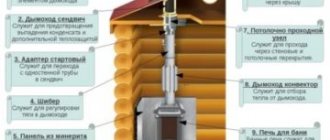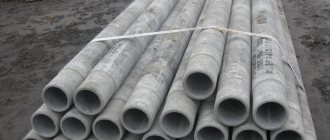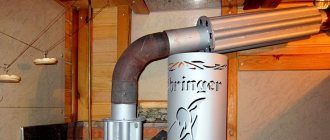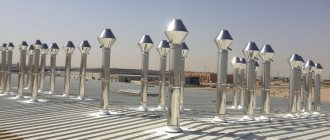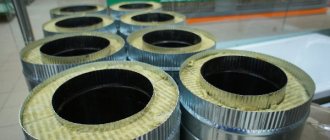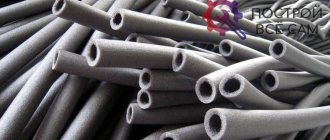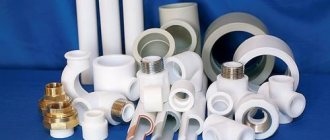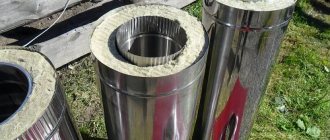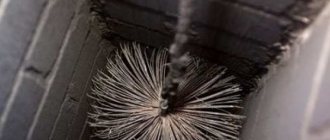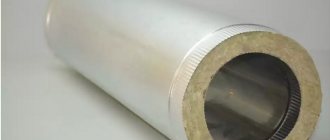What is a sandwich chimney
The name is quite self-explanatory: it is a three-layer construction. Its main elements:
- Internal circuit pipe, most often made of stainless steel.
- A larger diameter external circuit pipe made of stainless steel, optionally galvanized steel or sheet metal with a powder protective coating.
- Intermediate layer of thermal insulation.
Why do we need multilayer sandwich pipes for furnaces?
The operating conditions of chimneys can be called extreme:
- Extremely high temperatures.
- Exposure to open flame.
- Temperature fluctuations.
- Accumulation of combustion products requiring systematic removal.
However, it is temperature changes that have the greatest destructive effect, because As a result of this process, condensation is formed. Mixing with combustion products, ordinary water turns into a reactive mixture of coal, nitric and sulfuric acids, which provokes erosion of the chimney material.
To minimize temperature fluctuations caused by the external environment, the chimney should be insulated. And it is multilayer structures that cope with this task in the best possible way.
Thermal insulation layer
Thermal insulation plays an equally important role in creating a durable and safe smoke exhaust system. Its main functions:
- Maintain a certain temperature level in the inner part of the pipe to create working draft in the chimney and remove waste gases from the firebox.
- Avoid high temperatures in the chimney enclosing structures to avoid fire.
If the thermal insulation layer is made poorly, it will lose volume, settle, and over time, voids will appear, through which the high temperature will spread to the outer shell and to flammable materials. This could cause a fire.
In addition, low-quality insulation can quickly absorb moisture, sinter, or even coke. That is, it immediately loses its properties, forming cavities and exposing the outer shell to high temperatures.
The best option for a chimney would be insulation that does not contain adhesive components that can burn at a temperature of 500-600 °C.
TikTokers accuse Bill Gates of fake snow falling from the sky
Leos, give freedom: what prevents zodiac signs from raising children
An image that everyone will remember: 10 bright yellow coloring ideas for fashionistas
Design features of sandwich chimneys
Such modular designs are designed for socket connections. The structure of each module requires the presence of two mandatory elements:
- A slight expansion (bell) on one side.
- Slightly tapered, sometimes corrugated edge on the other side. The corrugation performs the function of a wedge, responsible for a tighter fit of the joined elements.
Particular importance is given to the type of connecting seam on the internal and external contours of the sandwich chimney. It can be welded or seam. The first one has the best strength characteristics, so it is better to choose it for the inner part (raincoat). There is less load on the outer casing, which means you can save money on it by giving preference to a seam seam.
How to carefully and correctly apply sealant
When working with both types of polymers, it is necessary to prepare the surface of the chimney: clean, remove dust and dirt, and degrease. It is advisable to sand the steel with fine sandpaper to improve polymer adhesion.
The surface under the heat-resistant sealant must be completely dry. The tube is inserted into the gun and a small amount of silicone is squeezed onto the joint to be sealed. Allow to harden (approximate time is indicated on the package).
The base for the heat-resistant silicate polymer is prepared and slightly moistened. Apply the sealant and let it harden. Excess heat-resistant mass is removed before the sealant hardens. You can apply masking tape along the joint in advance and remove it after application.
It is advisable to carry out work in warm weather.
Features of sealing sandwich chimneys
Sandwich pipes have a metal surface. Both silicate and silicone polymers are used to seal them.
A characteristic feature of sealing sandwich pipes is the need to seal both the inner and outer pipes. In addition to the general safety considerations that were given at the beginning of the article, it is very dangerous for a sandwich to get atmospheric moisture from the outside or condensation from the inside into the insulation.
The outer layer should be coated with silicone - it has excellent hydrophobic properties. For the internal joint, a heat-resistant sealant is selected depending on the type of heating device and the smoke temperature.
The sealing process itself is not particularly difficult - a bead of sealant is applied to the joining surfaces of the outer and inner layers and carefully spread with a layer of 1-2 mm using a spatula or a flat steel plate, then the chimney modules are joined together.
Service life of sandwich chimneys
Manufacturers' warranties range from 10-15 years. However, according to reviews from real users, such chimneys can last 25 years, and can burn out within 3-5 years of operation. Why?
Because the actual service life is influenced by many factors:
- Correspondence of steel type to operating temperature conditions.
- The quality of pipes, the presence or absence of manufacturing defects.
- Compliance with product care recommendations, systematic cleaning and visual inspection of the chimney for possible damage.
Any violation not only shortens the service life, but also threatens more serious problems - carbon monoxide poisoning or even fire.
Is sealing required?
Without a good seal, no chimney can function safely and reliably. Therefore, sealing is mandatory. In the case of using a steel chimney, sealants may be different, depending on:
- temperature parameters (heat-resistant);
- composition (two- or one-component);
- bases (silicone or silicate).
Stages of waterproofing the upper part of the chimney pipe
Other sealing methods can also be used. The main condition in this case is to ensure the required level of safety and reliability in operation.
Advantages and disadvantages of sandwich pipes for chimneys
I propose to evaluate the advantages and disadvantages of sandwich chimneys as correctly and comprehensively as possible, not from the point of view of a manufacturer focused primarily on making a profit, but from the point of view of an ordinary consumer and real reviews posted on specialized construction sites.
Let's start with the advantages:
- Ease. The construction of a sandwich chimney does not require the construction of a separate foundation for it; the supporting function can be performed by the boiler itself or a steel platform fixed to the wall, and the structure itself does not exert a significant load on the walls and ceilings.
- Simplicity and efficiency of installation. Even a beginner can handle assembling the modular design without any problems; no special equipment is required.
- Various fittings and special fasteners allow you to assemble a chimney of almost any configuration.
- Equipping with insulation minimizes heat loss, reduces the risk of burns, and also negates the main problem of all chimneys: the formation of condensation and, as a result, corrosion.
- Thanks to the absolutely smooth surface, not only less soot deposits accumulate inside, but also makes cleaning the structure easier.
- The round section is recognized by experts as the best shape: it improves the aerodynamic performance of air flow and traction.
- The external aesthetic appeal of metal allows you not to hide the chimney behind an additional decorative box.
Sandwich structures have fewer disadvantages, but they do exist:
- Relatively high cost. But this is fair when compared with conventional single-circuit steel chimneys. As for brick or ceramic analogues, sandwich structures are still cheaper, especially in comparison with installation costs.
- Short service life. Whatever one may say, brick and ceramic chimneys last much longer. However, their repair or reconstruction will require a lot of effort and finance, while replacing or repairing a sandwich chimney is much easier.
- Modular assembly increases the risk of depressurization, which can have disastrous consequences.
Round chimney
For a long time, the traditional solution was a typical brick chimney. However, technology develops and improves, and over time the chimney has acquired a rounded shape.
Sobyanin announced the passage of the “worst” stage of the pandemic
A pair of bush kangaroos at the Nizhny Novgorod Zoo "Limpopo" gave birth to a baby
Residents of a British city suffer an “invasion” of mountain goats at home: photo
This approach makes it possible:
- reduce the size of the mine several times;
- save time on cleaning the chimney, as there is no need to clean the corners;
- reduce the risk of fire - round chimneys significantly reduce the accumulation of soot, which can catch fire at any time.
In addition, the draft in a round pipe is better, which makes fuel combustion more uniform.
Is it possible to make sandwich pipes for a chimney with your own hands?
It is quite possible to make a multilayer sandwich structure with your own hands, the main thing is to comply with a number of requirements imposed by GOST for this kind of materials:
- For the internal casing, exclusively acid- and heat-resistant stainless steel sheets are selected, corresponding to the operating temperature conditions determined by the type of fuel on which the heat generator operates.
- For the outer casing, you can choose steel with reduced strength characteristics. Many people opt for galvanizing, but it should be remembered that when heated, it releases into the atmosphere substances that are not entirely harmless to human health.
- Only non-flammable heat-insulating materials are used as an intermediate layer. It is most convenient to work with rolled mineral insulation.
I propose to write down an algorithm for assembling a sandwich structure:
- A pipe blank is formed from heat-resistant steel, and the seam is carefully formed. This stage is perhaps the most important, because the resulting connection must be absolutely tight. If there is even the slightest doubt, it is better to buy a factory-made single-circuit steel pipe and carry out the rest of the work with it.
- Mineral insulation is wound tightly and evenly over the prepared internal contour (cloak) and secured with metal wire or special heat-resistant clamps.
- The resulting workpiece is wrapped quite tightly with sheet steel, chosen as the material for the outer casing, and the seam is fixed.
Of course, it will not be possible to achieve factory quality, but if making a multilayer structure yourself is the only option acceptable to you, then this technology can be used.
How to choose sandwich pipes for a chimney
Choosing a suitable model is a troublesome task that requires taking into account several aspects at once:
- The grade of steel used.
- Type of insulation.
- Dimensions such as the wall thickness of the inner raincoat and the insulation layer, the diameters of the inner and outer casings, the height (length) of the modular sections, the bending radius of the rotating elements.
The quality of the chimney pipe seams has an important influence on the trouble-free operation of the smoke duct. For a solid fuel boiler, priority should be given to laser-soldered products. A rolled (seam) seam can only be used in conjunction with a gas heat generator.
Material and wall thickness of the working inner tube of the sandwich
Only stainless steel types, including galvanized, are used as materials. The latter is most often used as an external pipe, but if connected to a gas boiler, it can also act as an internal circuit. However, it should be borne in mind that galvanized metal contains unsafe zinc, so many experts are against the use of galvanized ducts even in bathhouses.
Special alloyed (improved) steel grades are able to withstand high thermal loads and the effects of acid condensate.
When deciding on the grade of steel and its thickness, the first thing you should pay attention to is the type of material, or rather, its qualitative (ingredient) composition, which determines the strength and acid-resistant characteristics of the pipe. By choosing thicker steel that does not meet the operating conditions, you will not at all increase the service life of your smoke exhaust duct.
| steel grade | Features of the composition | Acid resistance | Inner/outer circuit |
| AISI 409 | Chrome (12%) | Low | -/+ |
| AISI 430 | Chrome (17%) | Low | -/+ |
| AISI 321 | Chrome (18%), nickel (10%), titanium (1%) | Average | +/+ |
| AISI 316 | Chromium (17%), nickel (12%), molybdenum (2%) | High | +/+ |
| AISI 304 | Chrome (18%), nickel (8%) | Average | +/+ |
| AISI 309/310 | Chrome (24%), nickel (20%) | High | +/+ |
| AISI 201 | Chrome (15%), nickel (1%) | Low | -/+ |
| AISI 444 | Chromium (18%), titanium (1%), molybdenum (2%) | High | +/+ |
The thickness of the walls of the internal working contour can vary from 0.5 to 1.5 mm, but when choosing between AISI 321 1 mm steel and AISI 316 0.5 mm steel, it is better to give preference to the latter.
No less important in determining the thickness of steel is the type of boiler for which it is selected:
- 0.5-1 mm – for gas and liquid fuel units.
- 0.8-1.2 mm – for solid fuel (coal and wood) heat generators.
- 0.8-1 mm – for sauna stoves.
- 1-1.5 mm – for gas piston, gas turbine and pyrolysis devices.
Table of operating temperatures for chimneys made of sandwich pipes of different steel grades
The choice of steel type is determined by the temperature of the flue gases and the acidity level of the condensate. They depend on the type of fuel:
- The lowest gas temperatures are produced by gas and diesel heat generators.
- The gases released as a result of coal combustion have the highest temperature, and wood has a slightly lower temperature.
- The most acidic condensate is the condensate that appears during the operation of liquid fuel (diesel) units and solid fuel devices operating in smoldering mode.
The table provides data only for those types of steel that are approved for use as an internal casing:
| Indicators | steel grade | |||||
| AISI 321 | AISI 316 | AISI 304 | AISI 309/310 | AISI 444 | ||
| Heat resistance | Above average | Average | Average | High | Average | |
| Maximum temperature | 600…700 °С | 450 °C | 450 °C | 1000 °C | 400 °C | |
| Fuel type | Gas | + | + | + | + | + |
| Diesel | — | + | — | — | + | |
| Coal | — | — | — | + | — | |
| Wood | + | — | — | + | — | |
Types and thickness of thermal insulation of sandwich pipes for chimneys
High temperature of flue gases is one of the conditions for good natural draft and a factor contributing to the reduction of condensate volume. In this regard, it is the insulation that is entrusted with the task of maintaining optimal temperature conditions inside the smoke circuit.
However, the choice of thermal insulation material must necessarily take into account the extreme conditions in which it has to work - extremely high temperatures and temperature changes. The latter is especially true for sections of the smoke channel exposed to the street.
Vermiculite, kaolin, basalt, fiberglass or ceramic wool are used as insulation. The thickness of the intermediate heat-insulating layer depends on the degree of heating of the flue gases and the location of the chimney (indoors or outdoors):
- For gas and liquid fuel boilers - 25-50 mm.
- For wood-burning installations – 50-75 mm.
- For coal and pyrolysis heat generators – 75-100 mm.
When taking the pipe outside, feel free to add at least another 25 mm.
On a note! For baths, the optimal material is considered to be basalt wool, which is neutral to conditions of high humidity. Fiberglass insulation is used only for gas installations with flue gas temperatures up to 350 °C.
Sandwich chimney diameter
There are many methods for calculating the diameter of the chimney duct, which will ensure that the optimal balance is maintained between the aerodynamic performance of the thrust and the cooling rate of the flue gases. These special calculations are usually very complex, so in private construction, the diameter of the internal channel is most often determined based on the power of the heat generator:
| Heat generator operating power | Minimum internal diameter |
| up to 3.5 kW | 115–158 mm |
| 3.5–5.2 kW | 158–189 mm |
| 5.2–7.2 kW | 180–220 mm |
| 7.2–10.5 kW | 220–226 mm |
| 10.5–14 kW | 226–263 mm |
| from 14 kW | 263–300 mm |
It is important to consider that:
- This calculation method is most fair for straight chimneys with a height of 5-5.5 m.
- The table shows the minimum diameter values; within the specified range it is better to give preference to a larger size.
- The first thing you should consider is the size of the smoke pipe of the heating installation. The diameter of the chimney pipe cannot possibly be smaller.
Number and type of sandwich pipe modules for chimneys
The number of sections and their type are determined by the height and configuration of the chimney. Straight modules usually have a length of 0.3, 0.5, 1 m. In addition to straight pipes, the following fitting elements are produced:
- Adapters from the smoke exhaust pipe of the heat generator to the sandwich (start-sandwich).
- Crosses and tees with different slopes (45°, 90°) for parallel connection to the chimney circuit of another heat generator or condenser collector.
- Bends (elbows) to change the trajectory of the smoke main to horizontal, inclined and again to vertical, or to bypass some structural element of the building with rotation angles of 45° or 90°.
- Condenser collectors with watering cans.
- Sections with an inspection window or slide valve (throttle valve), plugs.
- Support or cantilever platforms.
- Ceiling and wall walk-through mono-, thermal units.
- Unloading mono- and thermal fastenings with a support platform.
- Clamps, clamps with braces, wall fastenings, brackets (including support and telescopic).
- Roofing passage elements – roofs (supporting platforms with a passage hole), trench aprons (rosettes), master flushes.
- Modules for decorating the chimney head - rain mushrooms, umbrellas, deflectors, spark arresters, volpers.
How much do sandwich pipes for chimneys cost?
Pricing factors for sandwich chimneys:
- Steel grade and thickness. The greater the heat and acid resistance it has, the more expensive the products made from it.
- Type of thermal insulation material. Constructions with vermiculite insulation will cost the most.
- Type of connecting seam. The cheapest is folded.
The price of a sandwich chimney reflects its strength characteristics, and confidence in the safety of your family depends on them. Therefore, in such an important matter, you should not trust unverified manufacturers with uncertified products.
The golden rule for choosing stainless chimneys
A good chimney is also judged by its installation. When installing a steel chimney, the use of sealants, hammers, nails and screws is unacceptable. The chimney is assembled by inserting one element into another, and the joint is crimped with a clamp. This connection ensures high tightness and reliability.
The golden rule for buying a chimney is never take the price of one item as a guide. For example, the cost of a meter of pipe. Ask the manufacturer or retailer for a comprehensive quote to install the entire system. This way you can avoid pitfalls and compare real prices from different suppliers.
For example, cheap systems may have more fasteners and more expensive installation. Without paying attention to the comprehensive offer, which includes turnkey installation, you can get a low-quality chimney system at a good price.
Tips for sandwich chimney placement
Before installation, you should carefully consider the layout of the chimney. There are 2 methods of placing sandwich chimneys:
- Inside the house with the pipe leading out through the roof.
This scheme allows you to increase the energy efficiency of the house due to an additional heating source, protect the structure from negative atmospheric influences, reduce the volume of condensate, and naturally improve traction force. However, placing a chimney pipe in a building increases the risk of carbon monoxide escaping into the building and causing a fire. In addition, increased attention will be required to work on thermal insulation of passage areas through interior and roof ceilings, as well as sealing the place where the pipe exits to the roof.
- Exit the chimney pipe to the street immediately after connecting to the heat generator.
Here, all the advantages of the previous scheme are negated, but the safety of using the chimney is increased and the technology for bringing the pipe through the wall is simplified.
On a note! Sandwich chimneys of some heat generators, for example those operating in smoldering mode, according to SNiP requirements are prohibited from being placed inside a household.
When developing a chimney diagram, you should adhere to the following rules:
- Height is at least 5 meters.
- No more than 3 bends.
- The total length of horizontal sections is no more than 1 meter.
- It is prohibited to vent the chimney into the ventilation, as is the connection of ventilation lines to the chimney.
- Equal distance of the sandwich from the wooden elements of the rafter system.
- The minimum height above a roof made of combustible materials is 1.2 m, mandatory installation of a mesh spark arrester.
- The minimum elevation above a flat roof is 0.5 m.
- With a gable roof, the elevation level depends on the location of the pipe outlet:
- When removed from the roof ridge at a distance of up to 1.5 m - 0.5 m above the ridge element.
- When removed from the roof ridge at a distance of 1.5–3 m - at the level of the ridge.
- When removed from the ridge of the roof at a distance of more than 3 meters - at the level of a line drawn from the ridge element at an angle of 10° to the horizon.
- If there is a closely adjacent higher building, the pipe is installed above the latter.
- Mandatory presence of at least 1 audit compartment.
Important! The passage of a smoke sandwich pipe through residential premises is prohibited.
DIY chimney installation from sandwich pipes
I will outline the key points of the installation work for installing a sandwich chimney below. You can see more detailed instructions in the attached video.
Necessary tools and materials for installing a sandwich chimney
All components (modules) are prepared according to the previously developed scheme. In addition, you will need:
- Grinder for cutting holes in the ceiling, roof or wall.
- Drill for fixing fasteners to the supporting structure.
- Plumb.
- Heat-resistant sealant.
- Thermal insulation material for additional insulation of ceiling passage units.
Sandwich chimney assembly procedure
Assembling a sandwich chimney always starts from the bottom, i.e. from the boiler chimney pipe, and is conditionally divided into several stages:
- Making the transition from the chimney pipe of the heat generator to the sandwich.
- Installation of a section from the heat generator to the first passage unit (ceiling or wall).
- Installation and thermal insulation of the passage unit.
- Installing a section in the attic and designing the passage of the pipe through the roof (for chimneys located in the house).
- Assembling the street contour (along the wall or above the roof), fixing and designing the head.
Preparatory work before installing a sandwich chimney
Before starting the actual assembly of the sandwich chimney, a number of preparatory works are carried out:
- The chimney circuit is accurately marked.
- Mounting holes are punched in the places where the sandwich pipe passes through the walls, ceilings, and roof.
- The structural elements of the building, in which holes are punched for the pipe, are being strengthened.
- Supporting elements are installed - the basis for the entire sandwich structure.
We connect the elements of a sandwich structure
One of the main questions that should be decided before starting assembly is how the sandwich modules will be connected. There are several options:
- By smoke, when each subsequent section is put on the previous one. In this case, optimal conditions for draft are formed, and flue gases pass through the pipe absolutely unhindered. But in case of poor-quality sealing of the internal circuit, the resulting condensate has every chance of flowing into the insulation layer, which worsens its thermal insulation characteristics.
- By condensation, when each subsequent module is inserted into the socket of the previous one. Here, on the contrary, all conditions are created for free and trouble-free drainage of condensate. The inner pipe installed in the socket prevents moisture from entering the thermal insulation layer even if the sealing is insufficient, but smoke will end up in the room at the slightest crack.
Experts give the following recommendations:
- When the chimney is placed indoors, it is better to assemble it “according to the smoke”, because the risk of condensation is minimized.
- If the chimney pipe runs along the street, do the assembly along the “condensate”.
- To improve traction, it is better to collect horizontal and inclined sections using “smoke”, and vertical sections – “using condensate”.
The socket of each part should be thoroughly coated with fire-resistant sealant, but it is necessary to avoid the protrusion of sealant residues into the chimney pipe. Additionally, the joint is fixed with a special clamp.
Sandwich chimneys are attached to a vertical supporting structure with brackets every 2 meters, to inclined or horizontal ones - every 1 meter. The pipe is fixed on the roof using a special clamp with braces.
On a note! You can often come across advice to first assemble part of the structure on the floor, and then connect it to the main circuit. You shouldn't do this, because... When moving or connecting this unit, displacement and depressurization of the assembled modules is possible.
Connecting a sandwich chimney to a heat generator
Connecting the sandwich chimney to the boiler is an extremely important stage. Mistakes can lead to pipe burnout and fire, so you should follow the rules:
- When the boiler flue pipe is located on the side, the chimney rests on the heat generator.
- If the pipe is brought to the side, a support bracket with a platform is installed under the chimney and a section with a condenser collector with a drain valve is removed. The pipe itself is laid with a slight inclination towards the condenser collector (3° is enough).
- The first section of pipe extending from the nozzle must be single-layer (without insulation).
- A section with a slide valve for adjusting draft is also mounted here.
- The sandwich that is then installed must be equipped with a special plug for the heat-insulating layer.
Installation of a sandwich chimney through the ceilings and roof
The installation hole at the point where the chimney passes through the floors and roof should be 20 cm larger than the radius of the chimney itself. Installation of a ceiling pass-through unit (CPU):
- The exact location of the chimney passage is determined.
- It is additionally fixed.
- The free space between the ceiling and the pipe is filled with heat-insulating non-combustible materials, such as mineralite, expanded clay or basalt cardboard.
- The side part of the passage block is sewn up with a steel sheet.
At the point where the sandwich chimney exits onto the roof, a roof with a base that follows the slope angle of the roof, or a polymer master-flash, which must be heat-resistant, is installed. The latter is more convenient and provides greater tightness. A comfrey is mounted on top of the roof. The installation of each element is accompanied by careful sealing.
Important! It is prohibited to join sandwich pipes in ceiling, roof and wall passages. The places of their connections should be at least 25-30 cm away from the polyurethane foam.
Installation of a sandwich chimney through a wall
Technically, the passage through the wall is performed in the same way as in the previous case, however, there are important distinctive features:
- Due to the higher temperature of the flue gases in the lower part of the chimney, the diameter of the through installation hole increases by another 30 cm.
- To fill the free space of the passage unit, basalt or glass wool can be used.
- The condenser collector is brought outside and installed at a distance of at least 30–50 cm from the facade.
Important! It is prohibited to join sandwich pipes in ceiling, roof and wall passages. The places of their connections should be at least 25-30 cm away from the polyurethane foam.
How to connect a brick chimney with a sandwich pipe
For those who want to partially replace a brick chimney with a sandwich, manufacturers have developed a special module - a rectangular adapter with a pipe for a sandwich. After its installation, all work is carried out in accordance with the technology described above. This option is the most convenient, because... allows you to achieve maximum tight fit and tightness.
How to care for a sandwich chimney
The rules for maintenance and care of sandwich chimneys fully comply with the requirements for similar structures made of other materials:
- Systematic check of the condition of the chimney pipe for integrity, cleanliness and sufficient clearance for the free passage of flue gases.
To evaluate the latter, a small mirror can be used, which will need to be inserted into the pipe through the inspection hatch. Don’t forget to check the head, where birds often build their nests.
- Periodic cleaning of soot from pipes before the start of the heating season. During it - if necessary.
For cleaning, special brushes are used. To prevent and reduce the intensity of the formation of soot deposits, special preparations are used that are burned in the furnace of the heat generator.
Important! It is prohibited to burn soot with fire; this not only negatively affects the service life of the chimney, but can also cause a fire.
Welds
It is believed that this is a weak spot in the smoke exhaust system. Welding destroys the protective metal layer, and it is in this area that the chimney can be subject to corrosion.
Poor quality seams may not be sealed, which will lead to the formation of flue gases that will escape to the outside. An unacceptable option is spot welding or overlapping metal elements. The best solution in this situation is a continuous butt seam.
Always pay attention to the quality of the seams. Initially, pay attention to the seams of the fittings - tees, bends, support plates. Here, welding will cost much more than on straight pipes, so many unscrupulous companies can save on this.
